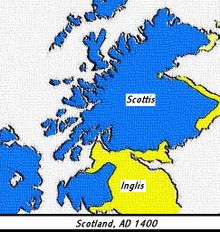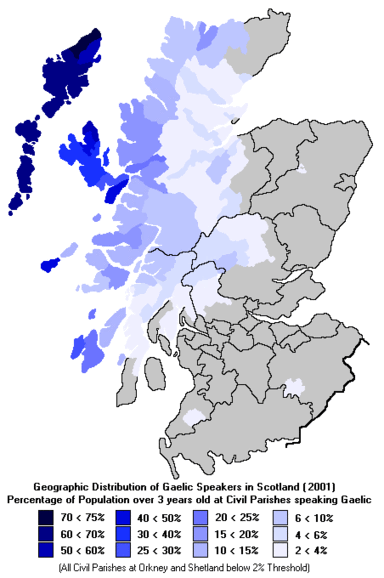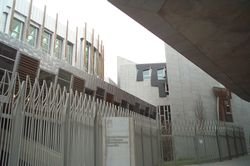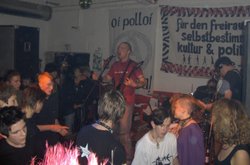Scottish Gaelic language
2007 Schools Wikipedia Selection. Related subjects: Languages
| Scottish Gaelic Gàidhlig |
||
|---|---|---|
| Bilingual roadsign in Mallaig: |
||
| Pronunciation: | IPA: [ˈkɑːlʲəkʲ nə haˈɫapə] | |
| Spoken in: | Scotland, Canada | |
| Region: | Parts of the Scottish Highlands, Western Isles, Cape Breton, Nova Scotia; formerly all of mainland Scotland except the southeastern part (parts of Lothian and Borders) and possibly eastern Caithness. | |
| Total speakers: | 58,652 (Scotland, 2001 census), with an additional 500-1000 in Nova Scotia (See also External links below) | |
| Language family: | Indo-European Celtic Insular Celtic Goidelic Scottish Gaelic |
|
| Official status | ||
| Official language of: | Scotland | |
| Regulated by: | Bòrd na Gàidhlig | |
| Language codes | ||
| ISO 639-1: | gd | |
| ISO 639-2: | gla | |
| ISO/FDIS 639-3: | gla | |
| Note: This page may contain IPA phonetic symbols in Unicode. See IPA chart for English for an English-based pronunciation key. | ||
Scottish Gaelic (Gàidhlig) is a member of the Goidelic branch of Celtic languages. This branch includes also the Irish and Manx languages. It is distinct from the Brythonic branch, which includes Welsh, Cornish, and Breton. Scottish, Manx and Irish Gaelic are all descended from Old Irish. The language is often described as Scottish Gaelic, Scots Gaelic, or Gàidhlig to avoid confusion with the other two Goidelic languages. Outside of Scotland, it is occasionally also called Scottish or Scots, a usage dating back over 1,500 years, for example Old English Scottas. This usage is uncommon in Scotland because since the 16th century the word Scots has by-and-large been used to describe (Lowland) Scots, which developed from the northern form of early Middle English. In Scottish English, Gaelic is pronounced [ˈgaːlɪk]; outside of Scotland, it is usually [ˈgeɪlɪk].
History
Gaelic, a descendant of the Goidelic branch of Celtic and closely related to Irish, is the traditional language of the Scotti or Gaels, and became the historical language of the majority of Scotland after it replaced Cumbric, Pictish and Norse. It is not clear how long Gaelic has been spoken in what is now Scotland; it has lately been proposed that it was spoken in Argyll before the Roman period, but no consensus has been reached on this question. However, the consolidation of the kingdom of Dál Riata around the 4th century, linking the ancient province of Ulster in the north of Ireland and western Scotland, accelerated the expansion of Gaelic, as did the success of the Gaelic-speaking church establishment. Placename evidence shows that Gaelic was spoken in the Rhinns of Galloway by the 5th or 6th century.
The Gaelic language eventually displaced Pictish north of the Forth, and until the late 15th century it was known in Inglis as Scottis. Gaelic began to decline in mainland Scotland by the beginning of the 13th century, and with this went a decline in its status as a national language. By the beginning of the 15th century, the highland-lowland line was beginning to emerge.
By the early 16th century, Inglis speakers gave the Gaelic language the name Erse (meaning Irish) and thereafter it was invariably the collection of Middle English dialects spoken within the Kingdom of the Scots that they referred to as Scottis (whence Scots). Nevertheless, Gaelic still occupies a special place in Scottish culture, has never been entirely displaced of national language status, and is still recognised by many Scots, whether or not they speak Gaelic, as being a crucial part of the nation's culture. Of course, others may view it primarily as a regional language of the highlands and islands.
Gaelic has a rich oral (beul aithris) and written tradition, having been the language of the bardic culture of the Highland clans for several centuries. The language preserved knowledge of and adherence to pre-feudal laws and customs (as represented, for example, by the expressions tuatha and dùthchas). The language suffered especially as Highlanders and their traditions were persecuted after the Battle of Culloden in 1746, and during the Highland Clearances, but pre-feudal attitudes were still evident in the complaints and claims of the Highland Land League of the late 19th century: this political movement was successful in getting members elected to the Parliament of the United Kingdom. The Land League was dissipated as a parliamentary force by the 1886 Crofters' Act and by the way the Liberal Party was seen to become supportive of Land League objectives.
Scottish Gaelic may be more correctly known as Highland Gaelic to distinguish it from the now defunct Lowland Gaelic. Lowland Gaelic was spoken in the southern regions of Scotland prior to the introduction of Lowland Scots. There is, however, no evidence of a linguistic border following the topographical north-south differences. Similarly, there is no evidence from placenames of significant linguistic differences between, for example, Argyll and Galloway. Dialects on both sides of the Straits of Moyle linking Scottish Gaelic with Irish are now extinct.
Current distribution in Scotland
The 2001 UK Census showed a total of 58,652 Gaelic speakers in Scotland (1.2% of population over three years old). Compared to the 1991 Census, there has been a diminution of approximately 7,300 people (an 11% of the total), meaning that Gaelic decline ( language shift) in Scotland is continuing. To date, attempts at language revival or reversing language shift have been met with limited success.
Considering the data related to Civil Parishes (which permit a continuous study of Gaelic status since the 19th century), two new circumstances have taken place, which are related to this decline:
- No parish in Scotland has a proportion of Gaelic speakers greater than 75% any more (the highest value corresponds to Barvas, Lewis, with 74.7%).
- No parish in mainland Scotland has a proportion of Gaelic speakers greater than 25% any more (the highest value corresponds to Lochalsh, Highland, with 20.8%).
The main stronghold of the language continues to be the Western Isles (Na h-Eileanan Siar), where the overall proportion of speakers remains at 61.1% and all parishes return values over 50%. The Parish of Kilmuir in Northern Skye is also over this threshold of 50%.
Proportions over 20% register throughout the isles of Skye, Raasay, Tiree, Islay and Colonsay, and the already mentioned parish of Lochalsh in Highland.
Regardless, the weight of Gaelic in Scotland is now much reduced. From a total of almost 900 Civil Parishes in Scotland:
- Only 9 of them have a proportion of Gaelic speakers greater than 50%.
- Only 20 of them have a proportion of Gaelic speakers greater than 25%.
- Only 39 of them have a proportion of Gaelic speakers greater than 10%.
Orthography
Old Irish, the precursor to both Modern Irish and Scottish Gaelic, was written in a carved writing called Ogham. Ogham consisted of marks made above or below a horizontal line. With the advent of Christianity in the 10th century the Latin alphabet was introduced to Ireland. The Goidelic languages have historically been part of a dialect continuum stretching from the south of Ireland, the Isle of Man, to the north of Scotland.
A form of Middle Irish, known as Classical Gaelic, was used as a literary language in Ireland until the 17th century and in Scotland until the 18th century. Later orthographic divergence is the result of more recent orthographic reforms resulting in standardised pluricentric diasystems.
The 1767 New Testament historically set the standard for Scottish Gaelic. Around the time of World War II Irish spelling was reformed and the Official Standard or Caighdeán Oifigiúil introduced. Further reform in 1957 eliminated some of the silent letters which are still used in Scottish Gaelic. The 1978 SCE recommendations for Scottish Gaelic were adopted by most publishers and agencies. In 1980 Scottish Gaelic orthography was further reformed by the Exam Board. Further reforms were recommended by the Board of Celtic Studies Scotland in a 1998 report entitled Computer-Assisted Learning for Gaelic: Towards a Common Teaching Core.
Manx orthography is based on English and Welsh and was introduced in 1610 by John Phillips, the Welsh-born Bishop of Sodor and Mann.
The modern Scottish Gaelic alphabet has 18 letters:
- A, B, C, D, E, F, G, H, I, L, M, N, O, P, R, S, T, U
The letter h, now mostly used to indicate lenition of a consonant, was in general not used in the oldest orthography, as lenition was instead indicated with a dot over the lenited consonant. The letters of the alphabet were traditionally named after trees (see Scottish Gaelic alphabet), but this custom has fallen out of use.
The quality of consonants is indicated in writing by the vowels surrounding them. So-called slender consonants are palatalised while broad consonants are velarised. The vowels e and i are classified as slender, and a, o and u as broad. The spelling rule known as caol ri caol is leathann ri leathann ("slender to slender and broad to broad") requires that a word-medial consonant or consonant group preceded by a written i or e be also followed by an i or e, and similarly if preceded by a, o or u be also followed by an a, o or u. Consonant quality (palatalised or non-palatalised) is then indicated by the vowels written adjacent to a consonant, and the spelling rule gives the benefit of removing possibly uncertainty about consonant quality at the expense of adding additional purely graphic vowels that may not be pronounced. For example, compare the t in slàinte ([slaːntʃə]) with the t in bàta ([paːtə]).
The rule has no effect on the pronunciation of vowels. For example, plurals in Gaelic are often formed with the suffix -an, for example, bròg [proːk] (shoe)/brògan [proːkən] (shoes). But because of the spelling rule, the suffix is spelled -ean (but pronounced the same) after a slender consonant, as in taigh [tʰɤj] (house)/taighean [tʰɤjən] (houses) where the written e is purely a graphic vowel inserted to conform with the spelling rule because an i precedes the gh.
In changes promoted by the Scottish Examination Board from 1976 onwards, certain modifications were made to this rule. For example, the suffix of the past participle is always spelled -te, even after a broad consonant, as in togte 'raised' (rather than the traditional togta).
Where pairs of vowels occur in writing, it is sometimes unclear which vowel is to be pronounced and which vowel has been introduced to satisfy this spelling rule.
Unstressed vowels omitted in speech can be omitted in informal writing. For example:
- Tha mi an dòchas (I hope) > Tha mi 'n dòchas
Once Gaelic orthographic rules have been learned, the pronunciation of the written language can be seen to be quite predictable. However learners must be careful not to try to apply English sound-to-letter correspondences to written Gaelic, otherwise mispronunciations will result. Gaelic personal names such as Seònaid [ˈʃɔːnɛdʒ] are especially likely to be mispronounced by English speakers.
Pronunciation
Vowels
Gaelic vowels have a grave accent, with the letters à, è, ì, ò, ù. The acute accent is sometimes seen in texts, with é and ó standing out, but generally, all vowels have a grave accent now.
| Spelling | Pronunciation | English equivalent | As in |
|---|---|---|---|
| a | [a] | cat | bata |
| à | [aː] | father | bàta |
| e | [ɛ], [e] | get, late | le, teth |
| è, é | [ɛː], [eː] | marry, lady | sèimh, fhéin |
| i | [i], [iː] | tin, sweet | sin, ith |
| ì | [iː] | evil | mìn |
| o | [ɔ], [o] | top, boat | poca, bog |
| ò, ó | [ɔː], [oː] | jaw, door | pòcaid, mór |
| u | [u] | brood | tur |
| ù | [uː] | brewed | tùr |
Diphthongs
| Spelling | Pronunciation | As in |
|---|---|---|
| ai | [a], [ə], [ɛ], [i] | caileag, iuchair, geamair, dùthaich |
| ài | [aː], [ai] | àite, bara-làimhe |
| ao(i) | [ɯː], [ᵚi] | caol, gaoil, laoidh |
| ea | [ʲa], [e], [ɛ] | geal, deas, bean |
| eà | [ʲaː] | ceàrr |
| èa | [ɛː] | nèamh |
| ei | [e], [ɛ] | eile, ainmeil |
| èi | [ɛː] | cèilidh |
| éi | [eː] | fhéin |
| eo | [ʲɔ] | deoch |
| eò(i) | [ʲɔː] | ceòl, feòil |
| eu | [eː], [ia] | ceum, feur |
| ia | [iə], [ia] | biadh, dian |
| io | [i], [ᴊũ] | fios, fionn |
| ìo | [iː], [iə] | sgrìobh, mìos |
| iu | [ᴊu] | piuthar |
| iù(i) | [ᴊuː] | diùlt, diùid |
| oi | [ɔ], [ɤ] | boireannach, goirid |
| òi | [ɔː] | fòill |
| ói | [oː] | cóig |
| ua(i) | [uə], [ua] | ruadh, uabhasach, duais |
| ui | [u], [ɯ], [ui] | muir, uighean, tuinn |
| ùi | [uː] | dùin |
Consonants
Most letters are pronounced similarly to other European languages. The broad consonants t and d and often n have a dental articulation (as in Irish and the Romance and Slavic languages) in contrast to the alveolar articulation common in English and other Germanic languages). Non-palatal r is an alveolar trill (like Italian r or Spanish rr.)
The " voiced" stops b, d, g are not voiced at all in Gaelic, but are rather voiceless unaspirated. The "voiceless" stops p, t, c are voiceless and strongly aspirated (postaspirated in initial position, preaspirated in medial/final position). Gaelic shares this property with Icelandic. In some Gaelic dialects, stops at the beginning of a stressed syllable become voiced when they follow a nasal consonant, for example: taigh 'a house' is [tʰɤi] but an taigh 'the house' is [ən dʰɤi]; cf. also tombaca 'tobacco' [tʰomˈbaxkə].
The lenited consonants have special pronunciations: bh and mh are [v]; ch is [x] or [ç]; dh, gh is [ʝ] or [ɣ]; th is [h], [ʔ], or silent; ph is [f]. Lenition of l n r is not shown in writing.
fh is almost always silent, with only the following three exceptions: fhèin, fhathast, and fhuair, where it is pronounced as [h].
| Radical | Lenited | ||||
|---|---|---|---|---|---|
| Orthography | Broad | Slender | Orthography | Broad | Slender |
| b | [p] | [p] | bh | [v] | [v] |
| c | [kʰ, xk] | [kʰʲ, çkʲ] | ch | [x] | [ç] |
| d | [t] | [ʤ] | dh | [ɣ] | [j] |
| f | [f] | [f] | fh | silent | silent |
| g | [k] | [kʲ] | gh | [ɣ] | [j] |
| l | [ɫ] | [ʎ] | l | [ɫ] | [l] |
| m | [m] | [m] | mh | [v] | [v] |
| n | [nɰ] | [ɲ] | n | [n] | [n] |
| p | [pʰ, hp] | [pʰ, hp] | ph | [f] | [f] |
| r | [r] | [r] | r | [r] | [ɾʲ] |
| s | [s] | [ʃ] | sh | [h] | [h] |
| t | [tʰ, ht] | [tʃʰ, htʃ] | th | [h] | [h] |
| bilabial | labiodental | dental | alveolar | postalveolar | palatal | velar | |
|---|---|---|---|---|---|---|---|
| plosive | p, b | t̪, d̪ | k, g | ||||
| nasal | m | n | ŋ | ||||
| trill | r | ||||||
| flap | ɾ | ||||||
| fricative | f, v | s | ʃ | x, ɣ | |||
| affricate | ʧ, ʤ | ||||||
| lateral | l, ɫ | ʎ, j |
There are a few general features worth noting.
- Stress is usually on the first syllable: for example drochaid 'a bridge' [ˈtroxaʤ].
(Knowledge of this fact alone would help avoid many a mispronunciation of Highland placenames, for example Mallaig is [ˈmaɫɛkʲ]. (Note, though, that when a placename consists of more than one word in Gaelic, the Anglicised form is liable to have stress on the last element: Tyndrum [taɪnˈdrʌm] < Taigh an Droma [tʰɤin ˈdromə]. This is because, unlike English, Gaelic word order places the specific element - adjectives, genitives - after the generic.)
- A distinctive characteristic of Gaelic pronunciation (which has influenced the Scottish accent – cf. girl [gʌrəl] and film [fɪləm]) is the insertion of epenthetic vowels between certain adjacent consonants, specifically, between sonorants (l or r) and certain following consonants:
- tarbh (bull) — [tʰarav]
- Alba (Scotland) — [alapa].
- Schwa [ə] at the end of a word is dropped when followed by a word beginning with a vowel. For example:
- duine (a man) — [ˈtɯnʲə]
- an duine agad (your man) — [ən ˈdɯnʲ akət]
Grammar
Official recognition
After centuries of persecution, prejudice and neglect, Gaelic has now achieved a degree of official recognition with the passage of the Gaelic Language (Scotland) Act 2005.
As well as being taught in schools, including some in which it is the medium of instruction, it is also used by the local council in the Western Isles, Comhairle nan Eilean Siar. The BBC also operates a Gaelic language radio station Radio nan Gàidheal (which regularly transmits joint broadcasts with its Republic of Ireland counterpart Raidió na Gaeltachta), and there are also television programmes in the language on the BBC and on the independent commercial channels, usually subtitled in English. The ITV franchisee in the north of Scotland, Grampian Television, has a studio in Stornoway. Viewers of Freeview a non-subscription digital TV service can receive channel, TeleG, which broadcasts for an hour every evening.
A full Gaelic language TV service, however, similar to S4C in Wales and TG4 in Ireland, has been under consideration. As in Wales, the showing of programmes in the language as opt-outs on the main channels has been regarded as inadequate for the 58,552 who speak it, and as an annoyance to some of the English or Scots speaking 5,003,459 who do not. In fact, this annoyance may be largely assumed: the evidence is that at least one Gaelic television programme produced by the BBC attains viewing figures in excess of the number of Gaelic speakers that could view it in Scotland. No complaints are being received by the BBC about Gaelic-language television programmes on BBC TV channels, perhaps because subtitling them in English makes them equally accessible to non-Gaelic speakers.
Bilingual road signs (in both Gaelic and English) are gradually being introduced throughout the Gaelic-speaking regions in the Highlands and elsewhere across the nation. In many cases, this has simply meant re-adopting the traditional spelling of a name.
The Ordnance Survey has acted in recent years to correct many of the mistakes that appear on maps. They announced in 2004 that they intended to make amends for a century of Gaelic ignorance and set up a committee to determine the correct forms of Gaelic place names for their maps.
Historically, Gaelic has not received the same degree of official recognition from the UK Government as Welsh. With the advent of devolution, however, Scottish matters have finally begun to receive greater attention, and the Gaelic Language (Scotland) Act was confirmed by the Scottish Parliament on 21 April 2005.
The key provisions of the Act are:
- Recognising in legislation Gaelic as an official language of Scotland with 'equal respect' to English.
- Establishing the Gaelic development body, Bòrd na Gàidhlig, on a statutory basis to promote the use and understanding of Gaelic.
- Requiring Bòrd na Gàidhlig to prepare a National Gaelic Language Plan for approval by Scottish Ministers.
- Requiring Bòrd na Gàidhlig to produce guidance on Gaelic Education for education authorities.
- Requiring public bodies in Scotland, both Scottish public bodies and cross border public bodies insofar as they carry out devolved functions, to consider the need for a Gaelic language plan in relation to the services they offer.
Following a consultation period, in which the government received many submissions, the majority of which asked that the bill be strengthened, a revised bill was published with the main improvement that the guidance of the Bòrd is now statutory (rather than advisory).
In the committee stages in the Scottish Parliament, there was much debate over whether Gaelic should be given 'equal validity' with English. Due to Executive concerns about resourcing implications if this wording was used, the Education Committee settled on the concept of equal respect. It is still not clear if the ambiguity of this wording will provide sufficient legal force to backup the demands of Gaelic speakers against the whims of local councils.
The Act was passed by the Scottish Parliament unanimously, with support from all sectors of the Scottish political spectrum on the 21st of April 2005.
The Education Act of 1872, which completely ignored Gaelic, and led to generations of Gaels being forbidden to speak their native language in the classroom, is now recognised as having dealt a major blow to the language. People still living can recall being beaten for speaking Gaelic in school.
The first solely Gaelic-medium secondary school, Sgoil Ghàidhlig Ghlaschu, was opened at Woodside in Glasgow in 2006 (several Gaelic-medium primary schools and partially Gaelic-medium secondary schools also exist).
In Nova Scotia, there are somewhere between 500 and 1,000 native speakers, most of them now elderly. In May 2004, the Provincial government announced the funding of an initiative to support the language and its culture within the province.
In Prince Edward Island, the Colonel Gray High School is now offering two courses in Gaelic, an introductory and an advanced course, both language and history are taught in these classes. This is the first recorded time that Gaelic has ever been taught as an official course on Prince Edward Island.
The UK government has ratified the European Charter for Regional or Minority Languages in respect of Gaelic.
The Columba Initiative, also known as Iomairt Cholm Cille, is a body that seeks to promote links between speakers of Scottish Gaelic and Irish.
Church
In the Western Isles, the isles of Lewis, Harris and North Uist have a Presbyterian majority (largely Church of Scotland - Eaglais na h-Alba in Gaelic, Free Church of Scotland and Free Presbyterian Church of Scotland.) The isles of South Uist and Barra have a Catholic majority. All these churches have Gaelic-speaking congregations throughout the Western Isles.
There are Gaelic-speaking congregations in the Church of Scotland, mainly in the Highlands and Islands, but also in Edinburgh and Glasgow. Notable city congregations with regular services in Gaelic are St Columba's Church, Glasgow and Greyfriars Tolbooth & Highland Kirk, Edinburgh. Leabhar Sheirbheisean - a shorter Gaelic version of the English-language Book of Common Order - was published in 1996 by the Church of Scotland, ISBN 0-907624-12-X.
The relationship between the Church and Gaelic has not always been an easy one. The widespread use of English in worship has often been suggested as one of the historic reasons for Gaelic's decline. Whilst the Church of Scotland is supportive today, there is, however, an increasing difficulty in being able to find Gaelic-speaking ministers.
Personal names
Gaelic has a number of personal names, such as Ailean, Aonghas, Dòmhnall, Donnchadh, Coinneach, Murchadh, for which there are traditional forms in English (Alan, Angus, Donald, Duncan, Kenneth, Murdo). There are also distinctly Scottish Gaelic forms of names that belong to the common European stock of given names, such as: Iain (John), Alasdair (Alexander), Uilleam (William), Caitrìona (Catherine), Cairistìona (Christina), Anna (Ann), Màiri (Mary), Seamus (James). Some names have come into Gaelic from Old Norse, for example: Somhairle ( < Somarliðr), Tormod (< Þórmóðr), Torcuil (< Þórkell, Þórketill), Ìomhair (Ívarr). These are conventionally rendered in English as Sorley (or, historically, Somerled), Norman, Torquil, and Iver (or Evander). There are other, traditional, Gaelic names which have no direct equivalents in English: Oighrig, which is normally rendered as Euphemia (Effie) or Henrietta (Etta) (formerly also as Henny or even as Harriet), or, Diorbhal, which is "matched" with Dorothy, simply on the basis of a certain similarity in spelling; Gormul, for which there is nothing similar in English, and it is rendered as 'Gormelia' or even 'Dorothy'; Beathag, which is "matched" with Becky (> Rebecca) and even Betsy, or Sophie.
Many of these are now regarded as old-fashioned, and are no longer used (which is, of course, a feature common to many cultures: names go out of fashion). As there is only a relatively small pool of traditional Gaelic names from which to choose, some families within the Gaelic-speaking communities have in recent years made a conscious decision when naming their children to seek out names that are used within the wider English-speaking world. These names do not, of course, have an equivalent in Gaelic. What effect that practice (if it becomes popular) might have on the language remains to be seen. At this stage (2005), it is clear that some native Gaelic-speakers are willing to break with tradition. Opinion on this practice is divided; whilst some would argue that they are thereby weakening their link with their linguistic and cultural heritage, others take the opposing view that Gaelic, as with any other language, must retain a degree of flexibility and adaptability if it is to survive in the modern world at all.
The well-known name Hamish, and the recently established Mhairi (pronounced [va:ri]) come from the Gaelic for, respectively, James, and Mary, but derive from the form of the names as they appear in the vocative case: Seumas (James) (nom.) → Sheumais (voc.), and, Màiri (Mary) (nom.) → Mhàiri (voc.).
The most common class of Gaelic surnames are, of course, those beginning with mac (Gaelic for son), such as MacGillEathain (MacLean). The female form is nic (Gaelic for daughter), so Catherine MacPhee is properly called in Gaelic, Caitrìona Nic a' Phì.
Several colours give rise to common Scottish surnames: bàn (Bain - white), ruadh (Roy - red), dubh (Dow - black), donn (Dunn - brown), buidhe (Bowie - yellow).
Loanwords
The majority of Scottish Gaelic's vocabulary is native Celtic. There are a large number of borrowings from Latin, (muinntir, Didòmhnaich), ancient Greek, especially in the religious domain (eaglais, Bìoball from Ekklesia and Biblia), Norse (eilean, sgeir), Hebrew (Sàbaid, Aba) and Lowland Scots (briogais, aidh).
In common with other Indo-European languages, the neologisms which are coined for modern concepts are typically based on Greek or Latin, although written in Gaelic orthography; television, for instance, becomes telebhisean (cian-dhealbh could also be used), and computer becomes coimpiùtar (aireamhadair, bocsa-fiosa or bocsa-sgrìobhaidh could also be used). Although native speakers frequently use an English word for which there is a perfectly good Gaelic equivalent, they will, without thinking, simply adopt the English word and use it, applying the rules of Gaelic grammar, as the situation requires. With verbs, for instance, they will simply add the verbal suffix (-eadh, or, in Lewis, -igeadh, as in, Tha mi a' watcheadh (Lewis, watchigeadh) an telly (I am watching the television) (instead of "Tha mi a' coimhead air a' chian-dhealbh"). This was remarked upon by the minister who compiled the account covering the parish of Stornoway in the New Statistical Account of Scotland, published over 170 years ago. However, as Gaelic medium education grows in popularity, a newer generation of literate Gaels is becoming more familiar with modern Gaelic vocabulary.
Going in the other direction, Scottish Gaelic has influenced the Scots language (gob) and English, particularly Scottish Standard English. Loanwords include: whisky, slogan, brogue, jilt, clan, strontium (from Strontian), trousers, as well as familiar elements of Scottish geography like ben (beinn), glen (gleann) and loch. Irish Gaelic has also influenced Lowland Scots and English in Scotland, but it is not always easy to distinguish its influence from that of the Scottish variety. See List of English words of Scottish Gaelic origin
Source: An Etymological Dictionary of the Gaelic Language, Alexander MacBain.
Common Scottish Gaelic words and phrases with Irish Gaelic equivalents
| Scottish Gaelic Phrase | Rough English Translation | Irish Gaelic Equivalent |
|---|---|---|
| Fàilte | Welcome | Fáilte |
| Halò | Hello | Dia Duit (Literally "God be with you") |
| Latha math | Good day | Lá maith |
| Ciamar a tha thu? | How are you? | Go dté mar atá tú (Ulster Irish), Conas atá tú (Leinster/Standard Irish) |
| Ciamar a tha sibh? | How are you? (plural, singular formal) | Go dté mar atá sibh (Ulster Irish), Conas a tá sibh (Leinster/Standard Irish) |
| Madainn mhath | Good morning | Maidin maith |
| Feasgar math | Good afternoon | Trathnóna maith |
| Oidhche mhath | Good night | Oíche maith |
| Ma 's e do thoil e | If you please | Má is é do thoil é |
| Ma 's e (bh)ur toil e | If you please (plural, singular formal) | Ma is é bhfuir thoil é |
| Tapadh leat | Thank you | Go raibh maith agat |
| Tapadh leibh | Thank you (plural, singular formal) | Go raibh maith agaibh |
| Dè an t-ainm a tha ort? | What is your name? | Cad is ainm duit? |
| Dè an t-ainm a tha oirbh? | What is your name?(plural, singular formal) | Cad is ainm doibh? |
| Mar sin leat | Goodbye | Slán leat |
| Mar sin leibh | Goodbye (plural, singular formal) | Slán libh |
| Dè a tha seo? | What is this? | Cad é seo? |
| Slàinte | "health" (used as a toast [cf. English "cheers"] when drinking) | Sláinte |






